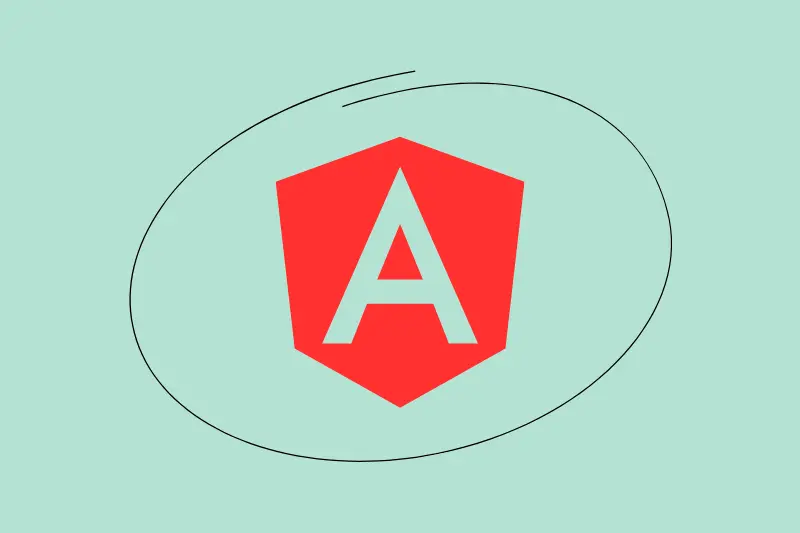In the discourse of Angular JS vs Vue.JS for 2024-2025, developers often grapple with the decision of which front-end JavaScript framework to adopt. While both frameworks possess unique advantages, it is essential to analyze their capabilities.
Angular offers a robust structure, especially since Angular 2, making it suitable for large-scale applications. In contrast, Vue is a lightweight framework that excels in simplicity and ease of integration, often attracting those who prefer Angular but desire a more flexible option.
Sometimes, for a new project, we choose a web and app development framework randomly based on the project's needs, the developer's choice, and the available expertise required to complete the project.
However, the main concept of choosing a framework for an enterprise will depend on the web and app development requirements and the suitability of the framework to match those needs.
People think settling on a framework and establishing a well-established web presence is easy.
However, there are many things we should consider when choosing a framework for a website or app development based on its performance, speed, reliability, maturity, stability, learning curve, community support, and efficiency in delivering results.
Keep this context in mind while choosing a web development framework. Selecting a framework is a science, as it requires expertise and related experience to understand the project's needs and create a suitable web and software development environment.
Our focus in this writing will be on AngularJS and VueJS. Both platforms have different features and functional abilities, making developers and businesses unsure about which one to choose. However, we have tried our best to make you comfortable choosing between Vue and Angular.
Statistics of Frameworks - Popularity Always Matters
Let's see Google Trends for AngularJS and VueJs. This is going to be an amazing fight between both of these technologies. Both of these are the best in their segment and performing powers.
According to w3techs, AngularJS is utilized by 0.3% of all websites, giving it a 0.3% market share of the JS library.
Other statistics show that the website and mobile app development languages utilized by software programmers worldwide as of 2020 are by deployment type. According to the reports, 62.3% of developers utilized JS (JavaScript).
JS is the only platform running on the path because many siblings are in the race, offering more powerful options for web development. Vue, Node.Js, React Native, and AngularJS are some of the widely used front-end development frameworks. All these frameworks utilize JavaScript as the core and base for developing attractive and more capable applications.
Why JS Frameworks?
There are many reasons behind JS's fame. Many libraries are available in JavaScript, which makes system development very easy. The latest JS capabilities are vested in the top three frameworks: React.Js, Angular.Js, and Vue.Js. But the lock horn in this writing is between Angular vs Vue.js. And we assure you that after reading the whole blog, you can decide what is best for you.
Take a scenario: If you need to decide between chocolate, ice cream, toffee, or chocolate biscuit, what will you choose? It is a tough decision. If you like chocolate the most, it will undoubtedly be your first choice, and the rest will be your second option based on your mood and the priority you give to them.
Well, it is also true that no item decreases the other item's value. It is just your taste or requirement. In the same manner, your choice of a framework depends on your needs and project requirements.
So, Where to Go?
Don't worry we are going to show a clear picture of everything regarding these frameworks.
We can't say which front-end framework is the best. It will be your decision and your developer's choice, and it will also depend on the type of application you need for your business. However, we have listed some important aspects that should be considered before selecting a front-end framework.

There are mainly 6 points or elements should be considered while moving with a front-end JS framework is as follows:
- Popularity
- Learning Curve
- Library/Framework Size
- Flexibility
- Performance
- Community Support
Angular Framework

It is an open-source JS-based framework that helps develop robust and highly scalable web applications. A decade ago, Google launched a front-end development environment called Angular.Js. As a Google product, it is highly popular among businesses for developing front-end applications.
If we talk about its usage, understand it this way: most big names in Fortune 500 Organizations, such as WhatsApp, Forbes, and others, use this framework to develop their web applications. Since its origin, to keep it the best match for today's business needs, Google released its new version named Angular2 in 2016.
Many features vested in Angularjs development are responsible for making it the first choice of developers. It is a high-end and complete framework with an encompassing solution instead of just an array of libraries. It helps developers focus their tasks much faster by offering libraries and other solutions to help them develop. This is one of the reasons this framework was one of the top front-end frameworks in 2024-2025, having an impressive UI for users.
It is developed on TypeScript, which allows access to all its advantages, such as class syntax, awaits/async, arrow functions, etc. Including various object-oriented programming languages makes migration from OOP-based languages like Java and C++ easier.
When it is Ideal to Choose AngularJS?
- To develop feature-rich and large-scale web applications.
- Coding in TypeScript.
- To develop a web app based on OOP.
- To create hybrid, web or native applications for long-term use.
- To build real-time applications such as message apps, chat apps etc.
- Use it when you are searching for a scalable and reliable front-end framework.
The latest and updated version of Angular.Js is Angular.Js 8, which allows developers to include many features in their web development projects.
What is Inside AngularJs?
The framework utilizes real DOM. It is not easy to manage, as if you cannot control the flow, you will slip into deep coding well while finding issues or errors. Finding lots of bugs is risky and time-consuming. However, the real DOM inside Angular affects its performance and functional power when developing dynamic software applications. All these things result in the slow execution of this JS framework.
Advantages of AngularJS
- Broad community support as it is the oldest available framework for the mobile app development
- Component-based structure, so all the components allow reuse.
- Easy development in AngularJS.
- There are lots of built-in functionalities and libraries.
- Due to OOP it always needs good programmers having good programming knowledge.
- It has the capability to disperse a single block into multiple blogs.
Features of AngularJS
This framework has many big features for effective front-end development and helps developers keep working on improvements and growing. There is a huge list of features. Let's check some of them here:
1. High Modularity
It proceeds with the footprints of the MVC framework. Additionally, it includes many components for diverse functions. Developers can install every module whenever required, removing the requirement to install the basic modules.
2. Single Page App Development
AngularJS supports many SPA features. These features make developing and managing online forms easier and ensure effective results. Developers can take more control in managing and maintaining validation abilities while developing single-page apps. In this manner, the entire procedure becomes easier to fulfill the project's requirements.
3. Compartmentalized
With expert angular developers, creating apps using the AngularJS framework is easy. The main reason behind this is that the framework splits the whole app into diverse components. After that, developers can easily work and manage all these split components separately. Additionally, it has separate files for the distinctive development sections, namely main logic and design. Also, the Compartmentalization of work into separate components makes the whole web application development and deployment processes easy.
4. Massive Community Support
AngularJS is the oldest framework developed by the web giant Google, so it offers developers enormous community support and improves the framework itself. The developers available in the community support are experienced and capable of providing the best front-end development solutions. The community also calls IT companies and organizes conferences and webinars across the globe to provide information on new changes and advancements in the industry.
5. Supports MVC Architecture
One of the best features is its ability to help developers develop web applications. The inclusion of MVC architecture makes it very comfortable to develop web apps, which results in developers saving time and effort. With this framework, it is also possible to synchronize data automatically and efficiently with less effort.
6. Dependency Injection
Angular does not only refer to components or elements. Dependency injection is one of the important features related to this that separates it from other frameworks. This tends to be configurable dependencies. There is no need for developers in the presence of dependent apps or components to manually develop related dependent objects, as the injector of the framework will develop and inject them into the app code.
7. Dual Data Binding
Dual Data Binding is also a noticeable feature. Any change in the web application tends to directly impact the UI, and the same is true for the backend. Dual data binding is easy with this framework, as developers can do it with just a few code lines.
VueJs

It is also a feature-rich framework for developing user interfaces (UIs). As an independent tool for UI creation, it doesn't need any additional extensions. Evan You created this framework and released it in February 2014. It might be possible that not many companies are using this framework, but that doesn't affect its popularity among developers.
Vue's many inclusive features always attract developers to use it for web development. It is easy to learn and integrate. Developers can use it for complete single-page apps and represented components. Logical structure and component file layout are also included in this framework. Vuejs development for web apps doesn't ask for extra libraries and deals with 2-way reactive data binding.
When it is Ideal to Choose Vue.js?
- Supported by the community.
- To build lightweight and small apps.
- Highly flexible.
- High performance and quick apps development.
- Use it if you need to enter the market early.
- Easy migration from the existing framework however with limited resources.
Vue allows easy integration with distinctive libraries. It also has some good browser dev tools extensions. These extensions help developers check the components' present condition and make the required changes.
Vue is small compared with other frameworks. This results in high-speed performance and decreases the deployment time. It contains documentation, which saves developers time in learning this front-end framework. Developers can start their journey with the basics of HTML and JS because this framework implements HTML-based template designs.
Advantages of VueJS
- All-inclusive documentation.
- It offers faster performance because of its small size.
- An easy learning curve.
- Integration of other programming languages is easier.
- It is the lightest framework.
- Simple to work with Vue.Js.
Features of Vue’s
1. Computed Properties
This is one of Vue's best features. It assists in understanding the changes made to the UI and performing the required calculations and upgrades. No additional coding is required to do all such things.
2. Easy Learning Curve
While learning or working with Vue is not required to learn other languages or frameworks except for JS, unlike other frameworks like React and Angular.
3. Data Binding
It helps to change the style, assign classes, and assign or manipulate values to HTML attributes. A binding directive known as v-bind is accessible with Vue.
4. Template
Vue provides HTML-based templates. It compiles and binds the templates into Virtual DOM Render functions. A web developer can easily use this function and replace the templates if necessary.
5. Vue.js Library
React.Js and Angular.Js are more suitable for developing large-scale web applications, but some things make Vue a better choice than both frameworks. For example, Redux in React has some disadvantages if used for the long term.
SEE ALSO : Angular Material vs Bootstrap
Let’s Check Out Vuejs vs Angularjs Comparison
| Titles | Angular.Js | Vue.Js |
| Deployment Speed | Challenging deployment as it handles everything from project development to code optimization. | The pre-coding structure allows quick deployment than other frameworks. It is ideal for start-ups. |
| Configuration | Coding in TypeScript | When you require HTML, Typescript and JavaScript |
| Framework Size | Largest size in 500KB | Lightest at 80KB(Bundle size). |
| Community Support | A wide community of supporters as well as professional developers | Open-source project supported and sponsored via crowd-sourcing |
| Developer-friendly | A fully structure-based framework | Use it if you need separation of components |
| Migration | Migration is not easy with Angular.js because of major updates every six months. | As 90% of the APIs remain the same so developers just need to utilize a migration helper tool to do the required changes. |
| Job market | The number of jobs are same in both Angular.js and React.js | There is a slight difference in the job market of Vue |
| Learning Curve | A deep learning curve | A small learning curve. Developers just need basic programming knowledge |
| Best Suitable For | Feature-rich and large-size applications | Suitable for single-page and lightweight web application development |
| Model-Base | Real DOM (Document Object Model)/ MVC (Model-View-Controller) architecture | Its model base is Virtual DOM and offers MVVM architecture |
| Functionality | Ideal for developing web apps, native and hybrid apps. | Ideal for started supporting native apps and advanced SPA |
SEE ALSO : Best Angular Component Libraries
Angular.js Vs Vue.Js - Who Wins the Race?
There is no debate on the importance and selection between Angular.Js and Vue.Js. Every framework has its pros and cons.
Angular can be your choice as a complete package and in terms of contributors. However, its learning curve is deep, and developers might take time to discover and resolve errors. So, it can be an ideal choice for companies having a big team of developers using Typescript.
Angular's main drawbacks are its size, startup time, and memory allocation capacity compared to Vue.
Vue is the newest in the market and does not have the backing of big companies. However, it works better than React and Angular in some ways. Some big names, like Baidu and Alibaba, use Vue as their primary UI framework. Vue can be your ideal choice if you like flexibility and simplicity.
You can choose any framework based on your project requirements. Do your research and Connect with us before working on any framework.
FAQs
Q: What are the main differences between Angular vs Vue?
A: The main differences between Angular vs Vue include their architectural design, learning curve, and community support. Angular is a full-fledged framework with comprehensive tools and features, while Vue is a progressive JavaScript framework that is more flexible and easier to learn. Angular tends to be more opinionated in its structure, whereas Vue allows for more freedom in building applications.
Q: Which framework should I choose for my next project: Angular or Vue?
A: The choice between Angular and Vue largely depends on the requirements of your project. If you are building a large-scale application that requires robust features, Angular might be the better option due to its extensive capabilities. However, Vue could be ideal if you prefer a more lightweight and flexible approach. It's important to consider the specific needs of your application and your team's familiarity with either framework.
Q: What are the key features of Angular?
A: Some of Angular's key features include two-way data binding, dependency injection, a powerful CLI (Angular CLI) for project scaffolding, component-based architecture, and a comprehensive routing system. These features help streamline development and enhance application performance.
Q: What are Vue's key features?
A: Vue offers several notable features, such as a reactive data binding system, a component-based architecture, a flexible and easy-to-use API, and a virtual DOM for efficient rendering. Vue also provides tools like Vue CLI for project management and Vue Router for handling navigation within applications.
Q: How do Angular and Vue compare in terms of performance?
A: Regarding performance, both Angular and Vue are designed to handle large applications efficiently. However, Vue's virtual DOM implementation can lead to faster rendering in some scenarios, especially with updates. Angular's change detection mechanism may require more resources, but both frameworks can perform well in various situations with proper optimization.
Q: Can I use Angular with React or Vue?
A: While it is technically possible to use Angular with React or Vue, it is generally not recommended due to the complexity it introduces. Each framework has its own architecture and design principles, which can lead to confusion and maintenance challenges. Sticking one framework per application is usually best for consistency and simplicity.
Q: How does Angular handle state management compared to Vue?
A: Angular provides built-in services and RxJS for state management, allowing for reactive programming and easier application state management. Conversely, Vue offers Vuex, a dedicated state management library that integrates seamlessly with Vue applications. Both frameworks effectively manage the state, but the choice often comes down to personal preference and the project's specific requirements.
Q: Is it easier to learn Angular or Vue?
A: Generally, Vue is considered easier to learn than Angular due to its simpler syntax and flexible design. Vue's documentation is also straightforward, making it accessible for beginners. In contrast, Angular has a steeper learning curve due to its comprehensive feature set and more complex architecture, which may require a deeper understanding of TypeScript and various design patterns.
Q: What are some common use cases for Angular applications?
A: Common use cases for Angular applications include enterprise-level web applications, single-page applications (SPAs), and applications that require strong data management and real-time updates. Angular's robust features make it suitable for applications that need to scale and maintain high performance over time.
Q: What are some common use cases for Vue applications?
A: Vue is commonly used for building interactive web interfaces, single-page applications, and lightweight applications that require quick development cycles. Its flexibility and ease of integration make it a popular choice for projects prioritizing rapid development and simplicity.


